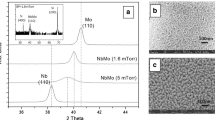Abstract
With the increase in integration and the layers of superconducting electronics circuits, molybdenum (Mo)-based films become attractive resistive and inductive functional components because of the large kinetic inductance with the deep magnetic field penetration depth. A DC magnetron sputtering technology is used to fabricate Mo and MoNx films. The effects of different deposition conditions on the electrical properties, topography and crystal structure of the films are investigated. For the Mo films, the resistivity and the surface roughness decrease to 193 nΩ m and 0.72 nm, respectively, as the sputtering power increases and the sputtering pressure is reduced. The dominant (110) peaks of the X-ray diffraction pattern show a blueshift, and the full width at half maximum decreases with the rising sputtering powers. For the MoNx films, the superconducting transition temperature firstly rises and then lowers as the ratio of N2/Ar ratio increases. The physical properties of the Mo and MoNx films change with the sputtering process, and suitable deposition conditions can be selected for the different application structures in the superconducting electronics circuits.







Similar content being viewed by others
References
L.A. Abelson, G.L. Kerber, Proc. IEEE 92(10), 1517–1533 (2004)
S.K. Tolpygo et al., IEEE Trans. Appl. Supercond. 28(4), 1100212 (2018)
D.E. Oates et al., Phys Rev B Condens Matter. 43(10), 7655–7663 (1991)
A. Kamlapure et al., Appl. Phys. Lett. 96(7), 072509 (2010)
A. Debelle et al., Appl. Phys. Lett. 84(24), 5034–5036 (2004)
T.J. Vink et al., J. Appl. Phys. 70(8), 4301–4308 (1991)
S.G. Malhotra et al., J. Appl. Phys. 79(9), 6872–6879 (1996)
D.W. Hoffman, C.M. Kukla, J. Vac. Sci. Technol. A: Vac. Surf., Films 3(6), 2600–2604 (1985)
L. Fabrega et al., IEEE Trans. Appl. Supercond. 19(6), 3779–3785 (2009)
Y.G. Shen, Mater. Sci. Eng., A 359(1–2), 158–167 (2003)
V.K. Semenov, Y.A. Polyakov, S.K. Tolpygo, IEEE Trans. Appl. Supercond. 29(5), 1302809 (2019)
S. Nagasawa et al., Physica C 412–414, 1429–1436 (2004)
S.K. Tolpygo et al., IEEE Trans. Appl. Supercond. 27(4), 1100815 (2017)
Jenkins, M.W., et al., in Proc. Conf. Proc. 44th Int. Symp. Testing Failure Anal. 148–152(2018).
D. Olaya et al., IEEE Trans. Appl. Supercond. 29(6), 1101708 (2019)
J.M. Murduck et al., IEEE Transactions on Applied Superconductivity. 13(2), 87–90 (2003)
S.K. Tolpygo et al., Supercond. Sci. Technol. 20(11), S341–S349 (2007)
Y. Wang et al., Supercond. Sci. Technol. 35(2), 025008 (2021)
R.E. Miller et al., Appl. Phys. Lett. 63(10), 1423–1425 (1993)
S. Nagasawa et al., IEICE Trans Electr. E97.C(3), 132–140 (2014)
S.K. Tolpygo et al., IEEE Trans. Appl. Supercond. 17(2), 946–951 (2007)
S.K. Tolpygo et al., IEEE Trans. Appl. Supercond. 26(3), 1100110 (2016)
S.K. Tolpygo, Low Temp Phys. 42(5), 361–379 (2016)
S.K. Tolpygo et al., IEEE Trans. Appl. Supercond. 29(5), 1102513 (2019)
Tolpygo, S.K., et al. Proc. Appl. Supercond. Conf. 1–29(2020).
S. Nagasawa et al., Supercond. Sci. Technol. 16(12), 1483 (2003)
H. Numata et al., IEEE Trans. Appl. Supercond. 9(2), 3198–3201 (1999)
D. Yohannes et al., IEEE Trans. Appl. Supercond. 15(2), 90–93 (2005)
W. Xiong et al., IEEE Trans. Appl. Supercond. 27(4), 1100304 (2017)
W. Xiong et al., IEEE Trans. Appl. Supercond. 28(4), 1300605 (2018)
L. Ying et al., IEEE Trans. Appl. Supercond. 31(5), 1301504 (2021)
T. Liang et al., IEEE Trans. Appl. Supercond. 30(7), 7500304 (2020)
V. Yefremenko et al., J. Low Temp. Phys. 199(1–2), 306–311 (2019)
N. Haberkorn et al., Mater. Lett. 215, 15–18 (2018)
P. Chelvanathan et al., Appl. Surf. Sci. 334, 129–137 (2015)
P. Chelvanathan et al., Thin Solid Films 638, 213–219 (2017)
F. Ichikawa et al., J. Phys: Conf. Ser. 969, 012064 (2018)
Acknowledgements
We acknowledge Huifang Gao for the help on XRD data analysis and acknowledge Kai Fu, Yong Shi, Zhiqiang Zhou and Zezhang Wang for the low temperature measurements.
Funding
This research was funded by Young Scientists Fund of the National Natural Science Foundation of China (61901432) and the Fundamental Research Projects in Basic Scientific Research at NIM (AKYZZ2125).
Author information
Authors and Affiliations
Corresponding author
Ethics declarations
Conflict of interest
The authors have no relevant financial or non-financial interests to disclose.
Additional information
Publisher's Note
Springer Nature remains neutral with regard to jurisdictional claims in published maps and institutional affiliations.
Rights and permissions
Springer Nature or its licensor (e.g. a society or other partner) holds exclusive rights to this article under a publishing agreement with the author(s) or other rightsholder(s); author self-archiving of the accepted manuscript version of this article is solely governed by the terms of such publishing agreement and applicable law.
About this article
Cite this article
Sun, X., Huang, M., Wang, Z. et al. Investigation of the Mo and MoNx Thin Films for Superconducting Electronics Application. J Low Temp Phys 210, 182–193 (2023). https://doi.org/10.1007/s10909-022-02915-5
Received:
Accepted:
Published:
Issue Date:
DOI: https://doi.org/10.1007/s10909-022-02915-5




